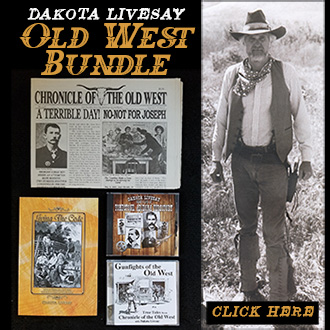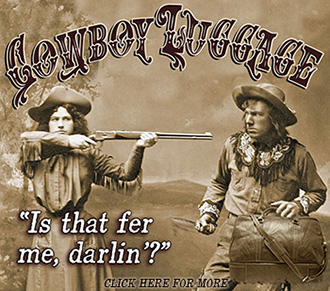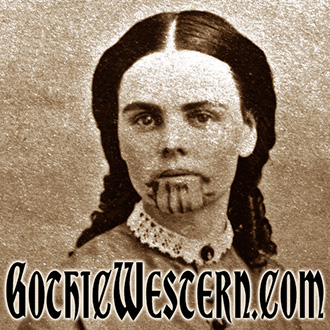Old West Book Review: Dragoons in Apacheland
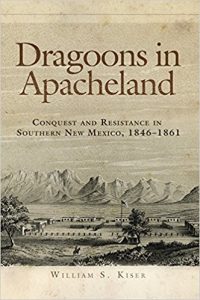 Dragoons in Apacheland details the fifteen years from 1846 through 1861 when the U.S. Army was engaged in dealing with the Apaches in southern New Mexico Territory. The conflicts and misunderstandings led to daily turmoil as the dragoons tried bringing peace and order to the region.
Dragoons in Apacheland details the fifteen years from 1846 through 1861 when the U.S. Army was engaged in dealing with the Apaches in southern New Mexico Territory. The conflicts and misunderstandings led to daily turmoil as the dragoons tried bringing peace and order to the region.
Deadly Apache raids, heat, dust, long marches in the desert, lack of decent food and shortages of equipment were only part of what the men were forced to put up with. Army posts usually consisted of crude huts, shabby tents, harsh weather, sick horses and mules, and sometimes squadrons of mosquitoes.
Meanwhile, civilian leaders and politicians from Washington to the Territorial governors, lawmen and regional mayors only added to the confusion. No one seemed to agree on how to handle this new land with its new problems. At the same time, various Apache bands including Mescalero, Mimbres, Mogollon and Chiricahua fought to hold their ancestral homelands. Indian raiding, kidnapping, horse and mule rustling and murder occurred regularly. Some of these Indians took the blame for others, while a few wise old leaders like Mangas Coloradas tried to negotiate peace. Mangas knew instinctively that the wave of white settlers would eventually wipe out the Apache bands by sheer numbers alone. He held off the inevitable as long as he could. The disputes raged endlessly between military men, Apaches, Mexicans, white settlers, and adventurers crossing the territory.
The author gives detailed accounts of the many skirmishes and battles between Apaches and the U. S. Military during those fifteen years prior to the Civil War. Anyone doing research about the Apache Wars and what led up to the 1880s Indian Wars will find this a valuable source of information. Readers will find this book a wonderfully detailed and accurate account of the pre-Civil War period in New Mexico Territory not often written about. This time period seems to have been skimmed over until now, perhaps because people think of the Indian Wars having always to do with the names we are familiar with such as Geronimo, who came much later.
Kiser points out the Apaches presented an obstacle to those politicians, ranchers, farmers and businessmen working toward civilizing the new frontier. Meanwhile, the Apaches driven from their land had good reasons of their own to offer resistance to those encroaching on their old way of life. Both sides of the problem are presented here in careful detail, without taking sides. The reader is given the opportunity to judge for his or herself what can happen when one civilization takes over another.
The book has maps showing the Chiricahua Apache homelands that extended from New Mexico (part of what is now southeastern Arizona) and far into Sonora, Mexico. Eventually part of New Mexico Territory would split off and become Arizona Territory. At the outbreak of the Civil War, the American troops were called back east for the horrific fighting about to begin. At that time New Mexico was not a priority for the United States government until the Civil War ended, and troops returned to the Western Frontier.
Carefully written and accurately documented, the author has gleaned his information from military records, U.S. government documents and publications, newspaper accounts and important books and papers on the subject. Personally, he explains how when he was a child, his father took him to some sites of the old abandoned forts. Here, sifting through the debris with a metal detector, he found a few precious mementos that piqued his interest to eventually write this book, an important addition to your Old West library. Be sure and get your copy HERE.
Editor’s Note: The reviewer, Phyllis Morreale-de Ia Garza is the author of numerous books about the Old West, including Hell Horse Winter of the Apache Kid, published by Silk Label Books, P.O. Box 700, Unionville, New York, 10988-0700 www.sllklabeIbooks.com.
*Courtesy of Chronicle of the Old West newspaper, for more click HERE.
Old West Book Review: Reshaw
 A Frenchman, his surname Richard was pronounced Reshaw by those who knew him, and this 1850s Old West character crisscrossed the frontier in what is now known as Wyoming and Colorado. While reading the book, it occurs to us that perhaps Reshaw was the inspiration for the Pasquinel character featured in James Michener’s Centennial.
A Frenchman, his surname Richard was pronounced Reshaw by those who knew him, and this 1850s Old West character crisscrossed the frontier in what is now known as Wyoming and Colorado. While reading the book, it occurs to us that perhaps Reshaw was the inspiration for the Pasquinel character featured in James Michener’s Centennial.
Richard was a contradiction who could be at one time very generous and at other times confrontational. The Indian tribesmen gave him a name in Sioux that meant “Always has plenty of meat” because he was willing to share with those in need. On the other hand, he could display a vicious temper and it was said that during a whiskey-drinking spree, he wildly drove his carriage into an emigrant train causing a stampede that killed several people.
Richard bought and sold commodities such as bacon in St. Louis, and sold it at highly inflated prices to the miners and travelers. He was a fur trapper, buffalo hide trader, whiskey peddler, livestock dealer and all around opportunist who always looked for ways to make money. By the time he was fifty years old the 1860 Colorado census records show his personal estate was worth $50,000, a huge sum for those days.
He married an Indian woman, and some of their children were eventually sent to St. Louis to be educated. This book goes into great detail about the lives of Richard’s children as well as his many business associates, as well as information about the history of Wyoming and Colorado, fights between the U.S. military and Indian tribes, attacks at stage stations and the numerous depredations that took place.
One of Richard’s most lucrative business ventures had to do with a toll bridge he constructed across the North Platte River near present day Casper, Wyoming. Richard was quick to see the advantage of charging the emigrant trains to cross their wagons, livestock and equipment over his bridge as they made their way west. He ran this operation for many years, but around 1865 he departed from his toll bridge business on the North Platte. It was suggested that due to his family connections with the Sioux Indians and other tribesmen, he was warned that big trouble was coming between the Indians and the U.S. government, and he would be wise to make himself scarce before it was too late. The Plains Indians were on the prod following the Sand Creek Massacre, and retribution would be forthcoming.
Even without his toll bridge business, Richard continued to be involved in various business ventures. He died a violent death where he camped along the banks of the Niobrara River. Supposedly he was transporting a large quantity of gold. While his body was recovered, it was never known for sure who the killers were. Both boot prints and moccasin tracks were found at the murder scene. Some men were suspected, one was arrested, but due to lack of evidence the murder of John Baptiste Richard remains an unsolved mystery.
This man was kind, he was clever, he was mean, he was generous, he was complicated. A husband, father, trail blazer, entrepreneur, he was a fascinating character that history has mostly overlooked until now.
The author has done a huge amount of careful research, presenting here not only the life of John Baptiste Richard but including a great deal of Wyoming and Colorado history. One photo in the book may or may not be that of John Baptiste Richard. It was labeled differently by several different historians. We might never know exactly what he looked like which only adds to his mystique. Grab your copy of this interesting book HERE.
Editor’s Note: The reviewer Phyllis Morreale-de la Garza is the author of numerous books about the Old West including Hell Horse Winter of the Apache Kid, published by Silk Label Books, P.O. Box 700, Unionville, New York. 10988-0700. Www.silklabelbooks.com
*Courtesy of Chronicle of the Old West newspaper, for more click HERE.
Old West Book Review: Riding Lucifer’s Line
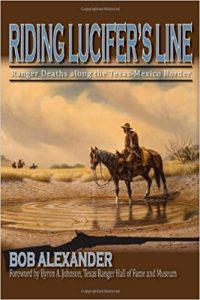 Retired lawman and veteran writer of more than a dozen non-fiction books about Old West history, Bob Alexander again writes a hard-hitting book. Riding Lucifer’s Line is a collection of 24 profiles about Texas Rangers who lost their lives on the Mexico-Texas border known as “Lucifer’s Line.” The chosen time period covers the last quarter of the Nineteenth Century through the first quarter of the Twentieth Century.
Retired lawman and veteran writer of more than a dozen non-fiction books about Old West history, Bob Alexander again writes a hard-hitting book. Riding Lucifer’s Line is a collection of 24 profiles about Texas Rangers who lost their lives on the Mexico-Texas border known as “Lucifer’s Line.” The chosen time period covers the last quarter of the Nineteenth Century through the first quarter of the Twentieth Century.
Carefully researched including newspaper accounts, personal letters, courtroom papers and official Texas Ranger documents, Alexander shows how the hard riding, straight-shooting Rangers rode with boldness into mortal danger. Their weapons of choice included Winchesters and the Colt’s .45 caliber six-shooters. They relied on horses for transportation, and faced every weather condition while crisscrossing the vast and untamed land. From choking dry desert and cactus-studded hills, to the swampy, mosquito infested marshes to the south, these men answered the call.
Alexander points out that Texas Rangers were sometimes hated and despised by the Hispanic population, even referred to as “devils”, by those who naturally resisted the new boundary after Texas split from Mexico. And while not all of the Rangers were angels on horseback, they dealt with the harsh realities of an unforgiving adversary good at ambush and body mutilation.
Sonny Smith was the youngest Ranger killed in the line of duty. At seventeen years he was shot down ambushed by a wounded desperado hiding in the weeds near a pond. John McBride and Conrad Mortimer were caught in a crossfire, trapped inside a shack by a Mexican lynch mob. Sam Frazier was killed by people he had threatened, and George R. “Red” Bingham was shot through the heart during a running gun battle with outlaws. Frank Sieker’s death was the result of a “terrible mistake” when Rangers mistook two Mexicans as horse thieves who were really leading horses of their own that had escaped, but due to language differences, the fight was on. Charles Fusselman was shot in the head during an ambush while chasing cattle thieves. Grover Scott Russell was ambushed inside a grocery store by the mother of the man he was trying to arrest. The lady used an axe.
The list of murdered Texas Rangers goes on and on, as readers find out what happened to whom, who the killers were and if they were brought to justice. These stories are real, and there are no happy endings when a young man in the prime of life is suddenly left dead riddled with bullet holes, or his skull crushed with an axe.
Two sections in the book provide photographs of many of these men and some others. A brief history of the Texas Rangers is explained in the book’s Foreword, and the Afterword gives yet another brief history lesson in what it took to be a Texas Ranger, details of their enlistment requirements and pay. Bob Alexander also explains how life on the Texas-Mexico border continues to this day to be a dangerous proposition. Horse and cattle rustling have now become mostly a war with drug cartels and human smugglers.
This book is a fast-paced, sentimental eye-opener into the lives of these twenty-four brave men who were determined to make Texas a safer place, but forfeited their own lives in the name of law and order. The struggle continues to this day.
Bob Alexander’s vast experience in law enforcement, border issues, and his love of Texas history once again come through in this latest book. Get your copy HERE.
Editor’s Note: The reviewer, Phyllis Morreale-de la Garza is the author of numerous books about the Old West including Silk and Sagebrush, Women of the Old West, published by Silk Label Books, P.O. Box 700, Unionville, New York 10988 www.silklabelbooks.com
*Courtesy of Chronicle of the Old West newspaper, for more click HERE.
Old West Book Review: The Life and Legends of Calamity Jane
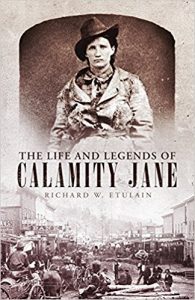 Martha Canary, better known as Calamity Jane, was a legend in her own time. Martha was born in Missouri in 1856, and had several younger siblings. Her father was a farmer and her mother a housewife who herself gained local notoriety as an eccentric with a volatile temper and a sharp tongue. When Martha was seven years old, the family left Missouri and headed “Out West,” first to Iowa and eventually to Montana. By the time Martha was eleven years old, both of her parents had died and she was alone in the world caring for the other children.
Martha Canary, better known as Calamity Jane, was a legend in her own time. Martha was born in Missouri in 1856, and had several younger siblings. Her father was a farmer and her mother a housewife who herself gained local notoriety as an eccentric with a volatile temper and a sharp tongue. When Martha was seven years old, the family left Missouri and headed “Out West,” first to Iowa and eventually to Montana. By the time Martha was eleven years old, both of her parents had died and she was alone in the world caring for the other children.
This book carefully delves into what is always challenging about the life of Martha Canary. Martha was illiterate; there is no known record of her writing or even a signature. As her life evolved, she became a tough character facing a tough world. Martha Canary traded face powder for gun powder, smoked cigars, drank whiskey, chewed tobacco, used rough language, drove mules and ox teams, quite possibly was involved in prostitution and during her drinking bouts was notorious for entertaining her bar buddies by howling like a coyote which resulted in her being thrown into jail more than once.
Martha’s reputation reached the ears and imagination of eastern writers who featured her character as the protagonist in a large collection of dime novels designed to entertain and shock eager readers anxious to learn about life in the Wild West.
Martha did travel in 1876 with General Crook’s expedition organized to fight the Sioux Indians. Known as the Big Horn and Yellowstone Expedition, the group consisted of nearly nine hundred officers, enlisted men, scouts and civilians. They headed up the Bozeman Trail with eighty supply wagons. Martha Canary was involved in this adventure, but her real role is difficult to pinpoint. She claimed later to have been a scout whose bravery dubbed her the nickname “Calamity Jane” when her derring-do saved one of the officers during an Indian attack. However, it is likely that she was merely a cook, or even a camp follower, since there is no official military record showing that she was hired as a scout.
It is true she was an eccentric woman who, long before it was socially acceptable, dressed like a man, drank, smoked, brawled, swore and fought her way in a rough and tumble frontier world. She did travel with a Wild West Show for a time, she did live in Deadwood, she did meet Wild Bill Hickok but it is highly unlikely there was a romance between them. Calamity was probably married at least once and gave birth to a daughter named Jessie. This poor child raised by an alcoholic mother and with no real father figure in her life, became a troubled person who in her old age was confused as to whether Calamity was her mother, grandmother or aunt.
This biography of Calamity Jane covers every facet of her life beginning with her ancestors to her death from alcoholism in Deadwood at age 47, in 1903. In her last years she sold a pamphlet filled with tall tales she dictated about her life. Readers were less interested in historical accuracy than entertainment. Since her death, numerous biographies, dozens of novels, hundreds of magazine articles and nearly twenty Hollywood movies have featured Calamity Jane.
From Doris Day to Angelica Huston, audiences have been treated to a gun-totin’ tobacco spittin’, buckskin clad gal who aimed to git her man with a gun. If you want to know anything about the life and legend of Calamity Jane, this is the book for you. The author has spent many years delving through books, articles, archival collections, old newspaper stories and family reminisces to set the record as straight as possible. But remember, once Hollywood gets hold of a character with a name like Calamity Jane, Billy the Kid, Wild Bill Hickok, Jesse James, Doc Holliday, Wyatt Earp or Johnny Ringo, there will never be an end to it. To get at the real story, get your copy HERE.
Editor’s Note: The reviewer, Phyllis Morreale-de ía Garza is the author of numerous books about the Old West, including the true crime Death For Dinner, The Benders of (Old) Kansas,, published by Silk Label Books, P.O. Box 700, Unionville, New York, 10988. www.silklabelbooks.com
*Courtesy of Chronicle of the Old West newspaper, for more click HERE.
Old West Book Review: Last of the Old-Time Outlaws
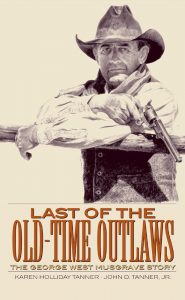 “He had a reputation as a cardsharp, cattle rustler, bandit, and killer,” and if George Musgrave had had a more romantic-sounding name, Hollywood might have cashed in on this amazing Old West character. In Last of the Old-Time Outlaws, you’ll get the true story.
“He had a reputation as a cardsharp, cattle rustler, bandit, and killer,” and if George Musgrave had had a more romantic-sounding name, Hollywood might have cashed in on this amazing Old West character. In Last of the Old-Time Outlaws, you’ll get the true story.
George West Musgrave was born May 27, 1877 in Atascosa County, Texas. His family ran a thirty-five hundred acre cattle outfit, and baby George was surrounded by tough people earning a hard living. The boy grew up surrounded by work, horses and guns. The Musgrave family consisted of various characters involved in gambling, horse rustling, and cattle theft which resulted in arrests and jailhouse stints. George even had a grandfather who had a long history of dueling, fights with Comanche, feuds with neighbors and “an inclination toward larceny.”
Excuses can be made for these influences on George, however, he began his career as a cowboy who could ride, rope, shoot and show off. He was known for “putting on shooting displays with a number of revolvers.” Soon he became involved in rustling with a devil-may-care attitude. He seemed always ready with a string of wisecracks. His popularity among his pals and cohorts became legendary.
His adventures led him back and forth from Texas into Old Mexico, then to New Mexico and sometimes Arizona. He joined what was known as the High Five or Black Jack gang. They spent years holding up stores, rustling cows, stealing horses, robbing banks and even trains. Musgrave was one of the gang members who took part in the first bank robbery in Arizona Territory. They also held up stagecoaches, and eventually pulled off the largest heist in the history of the Santa Fe railroad.
Musgrave was arrested and tried for the shooting death of a former Texas Ranger. When he miraculously avoided conviction, he migrated to South America where he took up his same old ways, now getting involved on a large scale with some big ranchers and South American politicians.
George was tail, handsome, soft spoken and popular with the ladies, too. During a trip back to Wyoming, Musgrave met an adventurous young woman named Jeanette “Jano” Magor. Twelve years younger than George, Jano was known for her smarts and toughness. Smitten with one another, the pair eloped. Jano followed Musgrave back to South America where she joined his dubious lifestyle. One photo shows the beautiful brunette dressed like a gaucho complete with her own shootin’ iron. She eventually grew weary of her husband’s philandering, and returned to the U.S. for a divorce.
After this, Musgrave had a succession of South American wives who produced children, all eventually either leaving him or hating him for his cavalier treatment of marriage vows.
Whether Musgrave was cheating at cards, robbing a bank, or shooting alligators, he joked about it all. He died in South America at age 70 of natural causes.
The Tanners have written a compete and thoroughly researched book about a tough, strong-willed man who could not resist danger and deviltry. The authors have a keen eye for unusual facts combined with a subtle and wonderful sense of humor that results in bringing the character of George Musgrave back to life. Readers will enjoy this book. Get yours HERE.
Editor’s Note: The reviewer Phyllis Morreale-de la Garza is the author of numerous books about the Old West including Death For Dinner, the Benders of (Old) Kansas, published by Silk Label Books, P.O. Box 700, Unionville, New York 10988 (845) 726-3434. www. silklabelbooks.com.
*Courtesy of Chronicle of the Old West newspaper, for more click HERE.
Old West Book Review: Chronicling the West For Harper’s
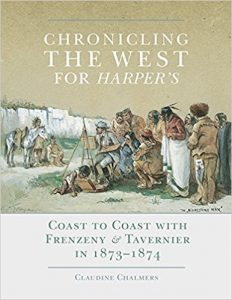 Chronicling the West For Harper’s. This fascinating book tells the story of two French artists, Paul Frenzeny and Jules Tavernier who were employed in 1873 by Harper’s Magazine to travel for one year across the great American frontier to chronicle immigrant migration. The men began in New York City and wound their way to San Francisco.
Chronicling the West For Harper’s. This fascinating book tells the story of two French artists, Paul Frenzeny and Jules Tavernier who were employed in 1873 by Harper’s Magazine to travel for one year across the great American frontier to chronicle immigrant migration. The men began in New York City and wound their way to San Francisco.
Paul Frenzeny was the son of a Hungarian nobleman. He had been a soldier in the French army, and eventually traveled to Mexico where he served as an artillery officer in the army of Maximilian. When Maximilian was defeated by the Juaristas, Frenzeny beat a hasty retreat back home to France by way of New York City. Here he became enamored with America and by using his considerable artistic talent and writing skills; he began working for Harper’s Magazine.
Jules Tavernier was the son of a British candy maker and grew up in France where he studied art with a Parisian master. After a stint in the military, he sailed for New York City were he immediately began building a reputation by producing expert artwork for important books and magazines, including Harper’s where he met Frenzeny.
When Harper’s cooked up the idea to publish realistic artwork showing immigrants crossing America, the magazine sent Frenzeny and Tavernier on a yearlong jaunt Out West. This book follows their trail from coast to coast as these two remarkable artists produced intricate drawings taken from their experiences as they traveled across the continent. Their sketches were transferred to wood cuts, and sent back to New York each week so readers could follow their adventures visually as well as in print. The result was a weekly flow of exceptional artwork combined with explanations of life on the frontier.
The men traveled by train, stagecoach and even horseback as they depicted life including glimpses of the manufacture of iron, and coal mining in Pennsylvania, plus train travel across Missouri, Kansas and Texas. There are log cabins, market days, sunsets, grazing cattle, homesteaders, woodcutters, Native Indians, prisoners en route to Ft. Smith, trader’s stores and even a vigilance committee preparing to hang outlaws for horse stealing.
Frenzeny and Tavernier worked relentlessly from place to place, following the immigrant trail, always looking for details surrounding everyday life. Their expert artistic talents picked up each and every nuance showing playful children, concerned mothers, thin over-worked animals, and dangers that lurked.
The book contains more than 130 marvelous illustrations along with the history lessons of author Claudine Chalmers whose keen eye directs readers’ attention to each important detail in the drawings. Chalmers has an uncanny way of observing what the artists must have seen as they watched argumentative washerwomen, snoozing pigs, defensive mother bears, dangerous river crossings, bustling cotton-gins, sugar-making in Texas, exciting deer hunts, market days and even abandoned towns after the railroads changed course. Coyotes digging through trash barrels and gnawing on dry bones in front of a dilapidated store tell the story. You’ll see prairie gnawing on dry bones in front of a dilapidated store tell the story. You’ll see prairie fires, buffalo slaughter, and Indian ceremonies. These wonderful illustrations include the Red Cloud Agency, work at a stone quarry, the emotions of a group of Mormon wives, and even the last of the Shoshone Indians begging at a railroad depot. The journey ends with scenes from San Francisco’s China Town.
This marvelous book combines history lessons from the 1870s era, along with exciting artwork you will marvel at time and again. It belongs as a special treasure in your Old West library. Get your copy HERE.
Editor’s Note: The reviewer Phyllis Morreale-de la Garza is the author of many books including Silk and Sagebrush; Women of the Old West, published by Silk Label Books, P. 0. Box 700, Unionville, New York 10988-0700 www.siIklabelbooks.com
*Courtesy of Chronicle of the Old West newspaper, for more click HERE.
Old West Book Review: The Sundance Kid
 Old West outlaw history has many “kids”, and the Sundance Kid is among the most popular. He teamed up with Butch Cassidy, and the two robbed banks, blew up railroad cars, stole money, buried loot, rustled horses, broke jail and foiled lawmen all the way from the United States to South America.
Old West outlaw history has many “kids”, and the Sundance Kid is among the most popular. He teamed up with Butch Cassidy, and the two robbed banks, blew up railroad cars, stole money, buried loot, rustled horses, broke jail and foiled lawmen all the way from the United States to South America.
Along the way many romanticized stories cropped up. Books, magazine articles, and even one popular movie had Butch and Sundance appearing in a variety of exciting situations. lt is true they belonged to The Wild Bunch, or Hole in the Wall Gang of robbers and rustlers in Old Wyoming. At one point in their career, they brazenly posed for a group photograph in a New York studio with members of their gang.
They rode hard, shot straight, plotted brazen holdups and get-aways, and even ran with a beautiful and mysterious woman known as Ethel (or Etta) Place. She traveled from New York to South America with them, was thought to be a Texas soiled dove, but disappeared from history before the men were hunted down and killed in Bolivia. All the possibilities surrounding Ethel’s life and what might have ultimately happened to her are explored here.
The author of this book is Donna Ernst, a member through marriage of the Longabaugh family, and she has spent many years delving into historical archives, family records, Pinkerton documents, letters and news accounts. Ernst has determined to set the story straight and takes the reader step by step from Harry Longabaugh’s childhood all the way to his death in Bolivia. She explains her sources of information and covers thoroughly Harry’s movements from childhood, to his work as an honest cowboy horse trainer, to his involvements in crime. She corrects some information about crimes he was blamed for, but other escapades she shows what part he played.
His crime spree began in the United States, and he spent some time in jail. Each time he was released he promised to go straight, but, but it always seemed too easy for him to drift back to a life of crime with his old pals. Eventually, when he was closely followed by American law enforcement authorities, he and Butch and Ethel departed for South America where they planned to become honest ranchers. However, the Pinkertons and other sheriffs were quick to figure out their whereabouts, and soon the trio was back on the run. They made friends in South America, but once they again began their outlaw ways, the locals naturally turned on them.
According to Ernst, down to their last two bullets, Butch and Sundance died of suicide in a shack surrounded by Bolivian police throwing Iead. Many writers show Burch and Sundance slipping back into the U.S. where they drifted in and out of their family’s lives. Several old men even claimed to be Butch or Sundance well into the 20th century. According to Ernst, one clever self-promoter may very well have been a Longabaugh relative, but certainly not Sundance himself.
The author makes a very strong case with good documentation that both Butch and Sundance died in Bolivia. This fascinating book takes the reader in a clear and concise writing style, along the outlaw trail of a man who might have been an upstanding, worthwhile citizen, but instead chose a life on the wild side.
This memorable book belongs in your Old West library. Get your copy HERE.
Publisher’s Note: The reviewer, Phyllis Morreale-de la Garza is the author of numerous books about the OId West including The Apache Kid, published by Westernlore Press, P0. Box 35305,Tucson, Arizona 85740.
*Courtesy of Chronicle of the Old West newspaper, for more click HERE.
Book Review: Six-Shooters and Shifting Sands
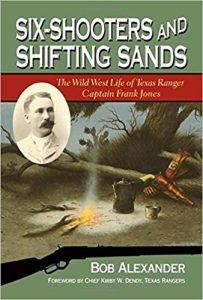 Author Bob Alexander had a long career in law enforcement. Combining this with his love of Texas, he now specializes in writing the biographies of various outlaws as well as lawmen, and here he takes aim at Captain Frank Jones of the Texas Rangers.
Author Bob Alexander had a long career in law enforcement. Combining this with his love of Texas, he now specializes in writing the biographies of various outlaws as well as lawmen, and here he takes aim at Captain Frank Jones of the Texas Rangers.
The book contains carefully researched information about the life and times of this brave man who was born in 1856 and died young, at age 37 in 1893. Jones’ remarkable career is filled with straight-shooting combined with faithful adherence to the laws of his State of Texas. These Rangers withstood unbelievable hardship as they helped create a safe environment for ranchers, settlers, townsfolk and adventurers alike. They dealt with never ending long days in the saddle, cold and heat, sudden political harangues and many uncertainties regarding their jobs and futures. Many of these men had no real personal lives, they were expected to be nearly superhuman in their promise to keep the peace.
Captain Frank Jones was born during tumultuous times in Texas during which Comanche swooped down on homesteaders, often kidnapping and murdering men, women and children. Comanche raiders combined with white rustlers, robbers, Mexican bandits and many miles between settlements and help was not a place for folks lacking grit. Frank’s mother Keziah Jones gave birth to her son on their lonely ranch while marauding Comanche terrorized the neighborhood.
Keziah’s photograph shows a severe, straight-laced and grim woman whose stare alone could stop most Comanche in their tracks. This photo and many others in the book show Frank’s family members, Ranger cronies, and important political figures he knew. With surnames like Hogg, Outhouse and Outlaw, this is better than what any fiction writer could possibly make up.
When Frank Jones joined the Frontier Battalion (later known as the Texas Rangers) he began chasing outlaws, and riding to the scenes of robberies, cattle rustling, fence cutting, murder, and every other depredation imaginable. No one could ask for a more exciting profession. Guns, horses, brawls, skulduggery. . . , it’s all here.
The book delves mostly into the career of Frank Jones, and touches only briefly upon his personal life. We find out he was married twice, his first wife was in fragile health and died soon after the couple’s second child was born. Frank had to put both children to live with relatives while he pursued his career. Sadly, the second child soon died. Several years later Frank married a divorced woman who had one son from her first marriage. Her ex was also a lawman, and a friend of Frank’s. She was pregnant with Frank’s son when Frank was killed during an ambush perpetrated by a gang of Mexican outlaws at a place called Pirate Island.
Frank Jones’ story ends with a tragic and fiery shoot-out between his group of Texas Rangers, and a Mexican gang well-hidden behind adobe walls. The Rangers rode right into a trap, and were cut down in a thunderous fusillade, leaving Captain Jones mortally wounded but still fighting back until his dying breath.
Today Frank Jones lies buried beneath his memorial monument in a cemetery near Ysleta, Texas. A sentimental photograph shows his old pals and comrades in arms circling his grave in remembrance. We see tough old Rangers in their twilight years respectfully resting their hands on the grave marker, their eyes shining with sadness, courage and respect. Some of these men were with Frank at Pirate’s Island the day he died.
Bob Alexander has once again written a valuable and memorable biography of an old-time Texas Ranger who deserves to be remembered. This book belongs in your Texas Ranger collection.
Author’s Note: The Reviewer, Phyllis Morreale-de la Garza is the author of many published books, including the novel Hell Horse Winter of the Apache Kid, published by Silk Label Books, P.O. Box 700, Unionville, New York 10988 (845-726-3434) www.silklabelbooks.com.
*Courtesy of Chronicle of the Old West newspaper, for more click HERE.
Book Review: Killer of Witches
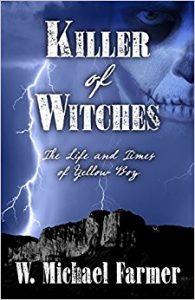 In Killer of Witches, the Spur Award winning author W. Michael Farmer delivers a carefully researched story of a Mescalero Apache’s adventures. Beginning in 1865, the boy, along with a small group consisting of his family and friends, “jump” the reservation at Bosque Redondo, New Mexico Territory where they have been unhappily confined.
In Killer of Witches, the Spur Award winning author W. Michael Farmer delivers a carefully researched story of a Mescalero Apache’s adventures. Beginning in 1865, the boy, along with a small group consisting of his family and friends, “jump” the reservation at Bosque Redondo, New Mexico Territory where they have been unhappily confined.
Their well-planned escape in dead of night is rewarded when they join a larger group of Apache fugitives hiding in Mexico. The reader is swept along with the Apaches, particularly Yellow Boy, as he grows into a much-feared warrior. He rides, shoots, becomes expert with bow and arrow as well as guns and practices all the rituals and traditions of his People. Along the way he meets some famous Apaches such as Juh and Victorio.
The location of the story includes New Mexico Territory, Arizona Territory, and Sonora and Chihuahua, Mexico. The reader really feels the descriptions of a harrowing life on the bronco trail. Heat, cold, storms, water shortages, dangers from wild animals and possible ambush by American troops, Mexican soldiers or renegade killers along the border is constant.
Yellow Boy dreams of a girl he likes, but wisely chooses another more suited to his dangerous lifestyle. Juanita fights beside him and is a woman to be counted on. She’s strong and smart, and totally devoted to her man.
A cantankerous old white man named Rufus Pike takes Yellow Boy under his wing and teaches him passable English as well as the expert handling of guns. Yellow Boy is tough and determined yet a thoughtful young man who tries to understand the rituals of the Apache god, Ussen. Both Apache and Spanish words and phrases are found throughout the story including their meanings.
As the story progresses, Yellow Boy has a frightening dream during which he thinks he has been spoken to by Ussen. He is warned that a mysterious apparition too horrible to think about has attacked Yellow Boy’s family campground in the mountains. When Yellow Boy rides to the rescue he discovers that sure enough, a sort-of Comanchero cross between a Mexican and a Comanche giant has murdered many of Yellow Boy’s relatives including his beloved father.
Known as “The Witch”, this hideous individual has taken over a hacienda and surrounds himself with captive women, fellow marauders, scalp hunters, murderers and thieves. The Witch, covered with tattoos, bird feathers and paint, dresses in an odd getup found only in poor Yellow Boy’s wildest nightmares. Armed with a pet owl trained to kill humans, this Witch becomes the villain of all villains. Quite likely the guy has smoked a little too much peyote.
Yellow Boy, armed only with his aged grandfather, his favorite gun, and two boyhood pals, must settle the score. The reader knows he’s being put-on by a clever and imaginative author who keeps readers glued to their book far into the night.
Well…, not too far into the night. I suggest you finish the story in the morning in the light of day when The Witch’s horrible face, his murderous rages, his gang of cutthroats, his mistreatment of women, and his diabolical urges to torture and kill anybody defying his authority won’t seem so scary. Besides, we have to find out what happens.
Does Yellow Boy beat The Witch? Read the book. You won’t be disappointed. But be careful, this book is the first of a trilogy featuring Yellow Boy and his nemesis, so we suspect even after turning the last page, there is still a lot more hard riding to do. Get your copy HERE.
Editor’s Note: The reviewer Phyllis Morreale-de la Garza is the author of many books including Hell Horse Winter of the Apache Kid, published by Silk Label Books, P.O. Box 700, Unionville, New York 10988-0700. www.silklabelbooks.com
*Courtesy of Chronicle of the Old West newspaper, for more click HERE.
Book Review: Wyatt in Wichita
 In the novel Wyatt in Wichita, readers of Western fiction will enjoy a look into the early life and times of Wyatt Earp. The author begins the story with the death of Wyatt’s wife Urilla, who died in Lamar, Missouri in 1870. At this time, Wyatt was 22 years old. Following this traumatic event, Wyatt travels to various towns throughout Kansas, and even up to Deadwood in the Dakotas while deciding what to do with his life. Heartbroken, confused, short of cash and blaming himself for the dearth of his wife, he runs into a variety of people both good and bad, who shape his future.
In the novel Wyatt in Wichita, readers of Western fiction will enjoy a look into the early life and times of Wyatt Earp. The author begins the story with the death of Wyatt’s wife Urilla, who died in Lamar, Missouri in 1870. At this time, Wyatt was 22 years old. Following this traumatic event, Wyatt travels to various towns throughout Kansas, and even up to Deadwood in the Dakotas while deciding what to do with his life. Heartbroken, confused, short of cash and blaming himself for the dearth of his wife, he runs into a variety of people both good and bad, who shape his future.
The problem with writing fiction using famous characters for the leading role is that the author must appeal to readers who have usually made up their minds well in advance of picking up a book. So much has been written about all the Earps, good, bad, and otherwise, it is hard to find anybody who does not have some preconceived ideas of what Wyatt Earp was really like. Was he a hero, or a self-serving cad?
The challenge for author Shirley, himself obviously a Wyatt Earp fan, was to keep readers turning pages even if they did not always agree with the author’s assessment of certain situations. Shirley is an experienced and clever writer who is able to keep the story moving forward by his good descriptions of life in the Old West, plus, he includes glimpses of other famous Western characters such as teenage Billy the Kid whom Wyatt tries to steer in constructive directions. Billy tags along with Wyatt throughout most of the book, and we see glimpses of his character as the young man struggles between right and wrong. He tries listening to Wyatt, but we can see a dark side to Billy that we know will eventually erupt in Lincoln County, New Mexico.
Meanwhile, to keep the reader guessing, Shirley has Wyatt involved in solving the murder of a beautiful young woman found strangled in his sister-in-law’s brothel. Bessie Earp, a madam in Wichita, is married to Wyatt’s older brother, James.
The story includes good descriptions of towns bustling with saloons, card games, buffalo hunters, peace officers and others who lived in these frontier settlements. Wyatt plays cards, gets into personal disagreements, and makes friends with the likes of Bat Masterson. Even Wild Bill Hickok and Calamity Jane put in brief appearances.
Trying to earn a living, Wyatt does wood cutting, law enforcement, riding shotgun for Wells Fargo, and even does a bit of gold prospecting. He stays in touch with his brothers and meets the difficult Mattie Blaylock who will eventually follow him to Tombstone, Arizona. While Mattie fawns over Wyatt now, she will eventually become a thorn in his side. However, this book does not get into the Tombstone part of Wyatt’s life. This story ends with him still in Kansas, trying to figure out where he will go next. Perhaps another Wyatt Earp story by this author will be forthcoming as a sequel, but don’t look here for the shootout at the O.K. Corral.
If you enjoy Western fiction filled with guns, card games, bad guys, peace officers and fast rides, you will like Wyatt in Wichita. Author Shirley has among his many credits co-screen writing the motion picture, The Crow, as well as having written television films for FOX and Paramount. Wyatt in Wichita is entertaining and fun in the tradition of historical western fiction. Shirley is an experienced storyteller who knows how to spin a good yarn. Grab your copy HERE.
Publisher’s Note: The reviewer, Phyllis Morreale-de la Garza is the author of numerous books about the Old West including The Apache Kid, published by Westernlore Press, P.O. Box 35305, Tucson, Arizona 85740
*Courtesy of Chronicle of the Old West newspaper, for more click HERE.
Book Review: First Territory
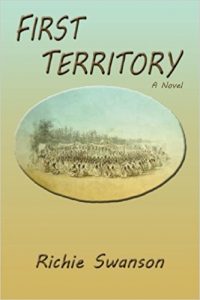 This novel tells of a young white man’s experience during the 1855-1856 Yakima War in the Pacific Northwest. The protagonist is Andrew Eaton, who works as a translator between American politicians, the U.S military commanders, and the Indians, thus he is traveling with important people and getting in on all that is happening.
This novel tells of a young white man’s experience during the 1855-1856 Yakima War in the Pacific Northwest. The protagonist is Andrew Eaton, who works as a translator between American politicians, the U.S military commanders, and the Indians, thus he is traveling with important people and getting in on all that is happening.
Andrew has learned the Indian language from his friendship with a beautiful Indian girl named Lalooh who ultimately does some translating too, since she has learned passable English from Andrew. However, throughout the story she stays with her family and as the story unfolds, she and Andrew only catch glimpses of one another.
Some background leading to this story, while only touched upon here, is the true debacle of Marcus and Narcissa Whitman who, ten years earlier before this story begins, had been brutally massacred along with twelve other white persons at their Mission in the Waiilatpu in what is now Oregon. Marcus was an American pioneer, doctor, and missionary among the Indians. Narcissa was one of the first white women to cross the continent. Their deaths occurred November 29, 1847. It is believed the Indians Marcus was trying to convert to Christianity became suspicious and enraged when a number of Indian children died in a measles epidemic and the Indians thought the Whitmans had poisoned them. Not until several white children died did the Indians understand the situation, but by then it was too late.
Now, ten years after the Whitmans’ deaths, there is continued feuding between the U.S. government, the various Indian tribes and white religious groups. Young Andrew finds himself caught in the desperate struggle between all these people as the Indian Wars in the Northwest finally grind to a close. Indian reservations are being established while leaders of the various tribes struggle between themselves as well as the new white government. Many misunderstandings, deep personal hatreds, loss of life and old traditional ways all come to a tumultuous clash by the end of the story.
Meanwhile, Andrew is in love with Lalooh and probably she has feelings for him too, but the situation is far too desperate and emotionally-charged for these two young people to resolve their differences and live happily ever after. Lalooh is faithful to her own people, even though she is roughly treated by an Indian who takes her for his wife. Andrew must watch and record while translating, and becomes embroiled in all the brutality on both sides. Andrew travels with his own people, while always on the lookout for Lalooh. His hared for the white governor becomes deeply entrenched in his feelings as he is caught between his job as translator and what is happening to the Indians.
Author Richie Swanson spent nearly thirty years beginning in 1977 exploring Indian reservations in the Northwest and researching the People’s long traditions. He writes with carefully crafted original detail, painting word pictures that sometimes cause the reader to flinch. Swanson’s writing is bold and unforgiving, some battle scenes are painfully revealing. The surprise, the sudden and fearful attacks and their aftermath remind us of all our years of human tragedy, war after war. Swanson’s writing goes deeper than an easy to read novel, he teaches truth along with entertainment. He really drives home what a gutsy, well-schooled novelist can do when endeavoring to rise above the average story-teller. Get your copy HERE.
Editor’s Note: The reviewer Phyllis Morreale-de la Garza is the author of numerous published books about the Old West, including the novel Widow’s Peak, published by Silk Label Books, P.O. Box 700, Unionville, New York 10988. Www.silklabelbooks.com
Book Review: Thunder Canyon
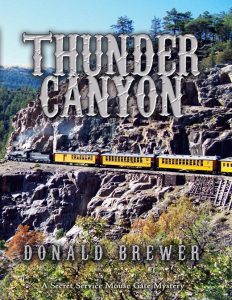 The novel Thunder Canyon is informative as well as fun reading for teenagers and adults alike. It is a fantasy/historical fiction about three modern teenage cousins who are magically transported back to the 1900 rip-roaring gold mining town of Cripple Creek, Colorado. The kids are both delighted and awed by the boardwalks, gambling saloons, Chinese workers, miners, gamblers, horses, wagons, no indoor plumbing, and the hustle and bustle. The contrast showing modern kids in a historical setting is amusing as well as filled with surprise. Occasional expressions like “awesome,” and “Hey, dude,” keep the reader chuckling as the kids are put to work spying on various members of a dangerous outlaw gang.
The novel Thunder Canyon is informative as well as fun reading for teenagers and adults alike. It is a fantasy/historical fiction about three modern teenage cousins who are magically transported back to the 1900 rip-roaring gold mining town of Cripple Creek, Colorado. The kids are both delighted and awed by the boardwalks, gambling saloons, Chinese workers, miners, gamblers, horses, wagons, no indoor plumbing, and the hustle and bustle. The contrast showing modern kids in a historical setting is amusing as well as filled with surprise. Occasional expressions like “awesome,” and “Hey, dude,” keep the reader chuckling as the kids are put to work spying on various members of a dangerous outlaw gang.
The real protagonist in the story is the grown up Eddie Donnally from New York, a Secret Service operative on the trail of a gang of counterfeiters who have set up shop in Cripple Creek. The gang consists of an angry woman bent on revenge, and her three brothers who are her accomplices. Unbeknown to Eddie, he has had a run-in with this family several years earlier in New York during which time their leader was sent to prison. Now, after moving to Colorado, the remaining gang members plan to kill Eddie when they discover their old nemesis is hot on their trail again.
The kids work as sleuths, passing information about what they have seen and who they have followed, while Eddie works the gambling saloons looking for signs of counterfeit money and who the culprits might be.
As readers turn the pages, we find sharp photos of 1890s rail cars, color photos of gold pieces known as Eagles, Double Eagles, and Half Eagles. There are pictures and descriptions of telegraph keys, burro descendants of those who worked in the Cripple Creek mines, arrest cards and photos of several real female counterfeiters apprehended in the old days by the Treasure Department, counterfeit coin-making equipment, Gold Mine Stock Certificates and counterfeit coin detectors from the 1890s.
The story includes train rides between Cripple Creek and the nearby town of Victor, a bit of romance between Eddie and an attractive town lady who runs a haven for stranded persons, and a helpful connection with the Chinese community. The story ends in a big shootout inside the gang’s mine hideout, right in keeping with a good old fashioned Western story.
The Appendix gives a detailed description of the game of faro including photos and information about dealers, players, and cheating (which sometimes ended in gunplay).
The author of this book is Donald Brewer, a 26-year veteran with the United States Secret Service. He was the Special Agent-In-Charge of the Counterfeit Division in Washington, D.C., and at one time worked undercover as case agent in the Atlanta Field Office. Later, in Miami, he spent eleven years closing down counterfeit manufacturing operations when Miami was known as the counterfeit capital of the world.
While retired now, Brewer’s obvious love for his job comes through in this story which is the second book in the “Mouse Gate Series” of adventures about catching counterfeiters. When not giving speeches and presentations regarding counterfeit U.S. currency, he is busy writing a third book for this series. Brewer has appeared on both the Discovery Channel and Learning Channel in an effort to educate the public on the issues of newly designed U.S. currency.
Thunder Canyon is not only an informative book for adults, but perhaps a step toward encouraging teenagers to read about life in the Old Wild West. Get your copy and get in on the fun HERE.
*Courtesy of Chronicle of the Old West newspaper, for more click HERE.


